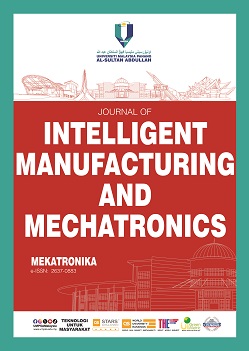Formulation of A Deep Learning Model for Automated Detection Via Segmentation of Lung Cancer
DOI:
https://doi.org/10.15282/mekatronika.v6i1.10389Keywords:
Lung Cancer, Pulmonary Nodules, Segmentation, Deep Learning, DeepLabV3Abstract
In 2020, the International Agency for Research on Cancer recorded nearly 20 million new cases of cancer around the world. It is estimated that cancer will be the second biggest cause of mortality worldwide in 2020, with over 10 million deaths. In Malaysia, the recorded number of new cases and deaths due to cancer in 2020 are 48639 and 29530, respectively. Lung cancer is the third most fre-quent cancer in Malaysia, and it also has the highest mortality rate, at 15.3 per-cent. Lung cancer has become a major public health issue in Malaysia, with only a 11% 5-year survival rate. Computed tomography (CT) scanning is the most common tool for early-stage lung cancer screening. One of the clinical signs of early lung cancer on CT imaging is pulmonary nodules, which are characterized as a small, opaque, roundish growth on the lung with a size of 7-30mm. There are two types of pulmonary nodules: benign and malignant (cancerous). The characteristic difference between malignant and benign nodules had make the pulmonary nodules segmentation significant as the radiologist can classify the malignancy of the nodules with the size of the nodules. Furthermore, radiologist can adjust the dosage of medication for malignant nodules patient, according to the size of the pulmonary nodules. The manual detection of pulmonary nodules in CT images is a tiring job as the radiologist may need to watch over 200 CT imag-es per CT scans. Luckily the advancement in machine learning technologies have paved way to new possibilities of pulmonary nodules detection and segmentation. and can integrate automation in solving repetitive manual intensive tasks. There-fore, this research investigates the diagnosis of lung cancer through CT images by using transfer learning and fine-tuning of the encoder. Hyperparameters such as type of number of epochs, optimizer and loss function are investigated on which combinations of these hyperparameters will yield the highest segmentation dice coefficient and Intersect over Union (IoU). Neural network architectures ResNet101 are evaluated as transfer learning encoder in extracting features from the patient’s CT images. The extracted fea-tures are then fed into the DeepLabV3 segmentation head to form a complete segmentation model. Subsequently, evaluating the combination of various pipe-lines, the loss and dice coefficient graphs are used to find the pipeline which performs the best in pulmo-nary nodules segmentation. This study indicated that the DeepLabV3-ResNet101-Adagrad Optimizer-Dice Loss pipeline yield the best performance. The pulmonary nodule segmentation models achieved a Dice Coefficient of 0.7983. The findings in this research will open new possibilities in screening method of lung cancer screening methods, offering more efficient and accurate detection of pulmonary nodules, ultimately improving patient outcomes.
References
“Cancer Today.” Accessed: Apr. 19, 2024. [Online]. Available: https://gco.iarc.fr/today/en
P. K. Nureylia Amir Nabihah Ali Sukumaran Raman Balqis Bahtiar Renuga Raman, NATIONAL CANCER REGISTRY DEPARTMENT National Cancer Institute, Ministry Of Health MALAYSIAN STUDY ON CANCER SURVIVAL (MySCan) National Cancer Institute Ministry of Health Putrajaya MALAYSIA Health Education Division Ministry of Health Putrajaya MALAYSIA i Malaysian Study On Cancer Survival (MySCan), 2018 MINISTRY OF HEALTH. 2014. [Online]. Available: http://nci.moh.gov.my/index.php/ms/main-menu-2/laporan
“TEN MOST COMMON CANCERS IN MALAYSIA,” 2007.
Y. Gu et al., “A survey of computer-aided diagnosis of lung nodules from CT scans using deep learning,” Comput Biol Med, vol. 137, Oct. 2021, doi: 10.1016/J.COMPBIOMED.2021.104806.
S. Jain, S. Indora, and D. K. Atal, “Lung nodule segmentation using Salp Shuffled Shepherd Optimization Algorithm-based Generative Adversarial Network,” Comput Biol Med, vol. 137, Oct. 2021, doi: 10.1016/J.COMPBIOMED.2021.104811.
P. Dutande, U. Baid, and S. Talbar, “LNCDS: A 2D-3D cascaded CNN approach for lung nodule classification, detection and segmentation,” Biomed Signal Process Control, vol. 67, May 2021, doi: 10.1016/J.BSPC.2021.102527.
K. bing Chen, Y. Xuan, A. jun Lin, and S. hua Guo, “Lung computed tomography image segmentation based on U-Net network fused with dilated convolution,” Comput Methods Programs Biomed, vol. 207, Aug. 2021, doi: 10.1016/J.CMPB.2021.106170.
M. Antonelli et al., “The Medical Segmentation Decathlon,” Nat Commun, vol. 13, no. 1, Jun. 2021, doi: 10.1038/s41467-022-30695-9.
R. C. Hardie, A. T. Trout, J. R. Dillman, B. N. Narayanan, and A. A. Tanimoto, “Performance Analysis in Children of Traditional and Deep Learning CT Lung Nodule Computer-Aided Detection Systems Trained on Adults,” American Journal of Roentgenology, vol. 222, no. 2, Feb. 2024, doi: 10.2214/AJR.23.30345.
L.-C. Chen, G. Papandreou, F. Schroff, and H. Adam, “Rethinking Atrous Convolution for Semantic Image Segmentation,” Jun. 2017, Accessed: Apr. 19, 2024. [Online]. Available: https://arxiv.org/abs/1706.05587v3
D. P. Kingma and J. L. Ba, “Adam: A Method for Stochastic Optimization,” 3rd International Conference on Learning Representations, ICLR 2015 - Conference Track Proceedings, Dec. 2014, Accessed: Apr. 19, 2024. [Online]. Available: https://arxiv.org/abs/1412.6980v9
S. Ruder, “An overview of gradient descent optimization algorithms,” Sep. 2016, Accessed: Apr. 19, 2024. [Online]. Available: https://arxiv.org/abs/1609.04747v2
J. C.Duchi, E. Hazan, and Y. Singer, “(PDF) Adaptive Subgradient Methods for Online Learning and Stochastic Optimization,” Journal of Machine Learning. Accessed: Apr. 19, 2024. [Online]. Available: https://www.researchgate.net/publication/220320677_Adaptive_Subgradient_Methods_for_Online_Learning_and_Stochastic_Optimization
L. R. Dice, “Measures of the Amount of Ecologic Association Between Species,” Ecology, vol. 26, no. 3, pp. 297–302, Jul. 1945, doi: 10.2307/1932409.
Downloads
Published
Issue
Section
License
Copyright (c) 2024 The Author(s)

This work is licensed under a Creative Commons Attribution-NonCommercial 4.0 International License.




